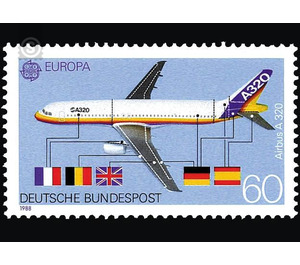Europe - Germany / Federal Republic of Germany 1988 - 60 Pfennig
Theme: Art & Culture
| Country | Germany / Federal Republic of Germany |
| Issue Date | 1988 |
| Face Value | 60.00 |
| Color | blue |
| Perforation | K 14 |
| Printing Type | Six-color offset printing |
| Stamp Type | Postage stamp |
| Item Type | Stamp |
| Chronological Issue Number | 1240 |
| Chronological Chapter | GER-BRD |
| SID | 389323 |
| In 58 Wishlists | |
The European Conference of Postal and Telecommunications Administrations (CEPT) has, in the context of the XI. Ordinary Plenary Assembly in Vienna as a theme for the European brands 1988 "Transport and communication tools" selected and recommended to present primarily modern means of transport, which meet the ecological requirements, as well as communication means, where the modern techniques are applied. This 150 seat aircraft successfully completed its maiden flight on February 22, 1987 and will be delivered to the first airlines from spring 1988. The development of this twin-engine aircraft is a joint effort of the European partner companies involved in Airbus Industrie (37.9%, Aerospatiale in France: 37.9%, British Aerospace: 20%, CASA in Spain: 4.2%). While France is responsible for the cockpit, the German industry is essentially concerned with the various fuselage segments, the interior equipment including the air conditioning and auxiliary turbine plant. The British industry is responsible for the wing, and the Spanish for the tailplane. As regards the slats, a subcontract was awarded to the Belgian industry. Each of the Airbus' engines has an output of 25,000 pounds of thrust each and gives this aircraft a range of 2,000 to 3,000 nautical miles, depending on the equipment. In their design, particular emphasis was again placed on low fuel consumption and low noise. In professional circles, he is therefore sometimes called the "whispering giant". Another key incentive is the fully electronic control of the A320 ("fly by wire"). Where used to be crowded in the cockpit series of pointer instruments, switches and control devices, now has the modern computer and control technology with screen displays and small, side-mounted control sticks move into. The use of new materials as well as the utilization of the latest findings in the field of aerodynamics and system technology round off this field and document in a convincing way the growth in technological capacity in European aircraft construction. (Text: Federal Ministry of Economics, Bonn)


